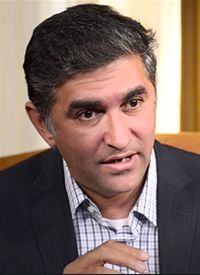Novel RAF Inhibitor BGB-283 Active in Multiple Tumor Types
BGB-283, a novel agent that targets <em>RAS/RAF</em>-mutated tumors, demonstrated activity across a variety of tumor types, according to the results of a preliminary clinical evaluation presented at the 2017 AACR Annual Meeting.
Jayesh Desai, MD

Jayesh Desai, MD
BGB-283, a novel agent that targetsRAS/RAF-mutated tumors, demonstrated activity across a variety of tumor types, according to the results of a preliminary clinical evaluation presented at the 2017 AACR Annual Meeting.
Treatment with the RAF dimer inhibitor BGB-283 led to clinical benefit for patients withBRAFV600-mutated melanoma, papillary thyroid cancer, and ovarian cancer. Antitumor activity also was observed inKRAS-mutated nonsmall cell lung cancer (NSCLC) and endometrial cancer. The orally administered drug demonstrated a favorable risk-benefit profile, suggesting potential for use as a single agent or in combination with other therapies appropriate forBRAF- andKRAS-mutated cancers.
“BGB-283 appears to have a desirable risk-benefit profile in the combined efficacy and safety data from the phase Ia and Ib parts of this study,” said Jayesh Desai, MD, a medical oncologist at Peter MacCallum Cancer Center in Melbourne, Australia. “The clinical activity of BGB-283 observed . . . warrants further investigation in the clinic.”
A second-generation BRAF inhibitor, BGB-283 inhibits RAF dimer and EGFR feedback activation. The agent exhibits potent and reversible inhibition ofBRAFV600E mutant and other RAF kinases and is a time-dependent inhibitor of BRAF kinases with very slow off-rates, said Desai. In preclinical testing, BGB-283 demonstrated activity against a variety ofBRAFandKRAS-mutated xenografts and patient-derived xenograft models.
Desai reported findings from a phase Ia/b clinical trial that began with a dose-finding evaluation that identified 40 mg once daily as the maximum tolerated dose and 30 mg daily as the recommended phase II dose. In the phase Ib dose expansion phase, patients with various types ofBRAF/KRAS-mutated advanced solid tumors received the recommended phase II dose.
During the phase Ia dose-escalation study involving 35 patients, antitumor activity was observed inBRAFandKRAS-mutated tumors, said Desai. Activity included 1 complete response in a patient withBRAFV600E-mutated melanoma; 1 partial response inBRAFV600E-mutated thyroid cancer; 1 partial response inKRAS-mutated endometrial cancer; and 1 unconfirmed partial response inKRAS-mutated NSCLC.
FDG-PET imaging at baseline and at the end of the first cycle of treatment with BGB-283 showed significant metabolic responses at doses of 20 mg and higher. Imaging data showed partial metabolic responses in 13 of 29 (45%) evaluable patients.
For the phase Ib evaluation, investigators enrolled 96 patients into 10 treatment arms: BRAF inhibitor/MEK inhibitor-naïve melanoma; BRAF inhibitor/MEK inhibitor-resistant melanoma; separate arms ofBRAFV600E-mutated colorectal cancer (CRC), NSCLC, and papillary thyroid cancer; separate arms ofKRAS/NRAS-mutated endometrial cancer, NSCLC, and CRC; otherBRAF-mutated and non-V600 BRAF-mutated cancers; and otherKRAS/NRAS-mutated cancers.
The 96 patients had a median age of 60, and men accounted for 56% of the total study population. Two thirds of the patients had ECOG performance status 1 (ECOG 0 for the rest); and about half had received at least 3 prior regimens (median of 3 prior regimens).
The efficacy summary showed 3 partial responses and 3 cases of stable disease among 7 evaluable patients withBRAFV600-mutated melanoma and no prior exposure to BRAF or MEK inhibitors. The objective response rate (ORR) was 42.9% and the disease control rate (DCR) was 85.7%. There was 1 partial response and 2 cases of stable disease among 3 patients withBRAFV600-mutated papillary thyroid cancer; and 1 partial response and 2 cases of stable disease in 6 patients withKRAS-mutated NSCLC (ORR, 16.7%; DCR, 50%).
In a group of 10 patients withBRAFnon-V600 mutations or other solid tumors withBRAFV600 mutations, the antitumor activity of BGB-283 consisted of 2 partial responses (1 patient each with V600E-mutated melanoma and V600E-mutated ovarian cancer) and 3 cases of stable disease. Additionally, 1 patient withBRAFV600-mutated NSCLC had a partial response and another achieved stable disease during treatment with BGB-283.
Desai reported that 4 of 6 patients withBRAFV600-mutated melanoma resistant to BRAF/MEK inhibitors attained stable disease, as did 9 of 13 patients withBRAFV600-mutated CRC. Stable disease was experienced by all 5 patients withKRAS-mutated endometrial cancer, 12 of 20 patients withKRAS/NRAS-mutated CRC, and 10 of 21 patients with otherKRAS/NRAS-mutated solid tumors or pancreatic cancer.
Median progression-free survival (PFS) was available for the groups with the longest follow-up. Overall, the median PFS was 5.4 months in those withKRAS-mutant endometrial cancer who were treated with an average of 3.2 prior therapies. The median PFS in theKRAS-mutant NSCLC group (2.7 prior therapies) was 4.2 months.
The most common drug-related adverse events (all grades) were fatigue (38.5%), dysphonia (26.0%), palmar-plantar erythrodysesthesia syndrome (21.9%), decreased appetite (21.9%), thrombocytopenia (19.8%), acneiform dermatitis (17.7%), rash (16.7%), diarrhea (16.7%), nausea (15.6%), and glossodynia (10.4%). Grade 3/4 adverse events were relatively infrequent, the most common being fatigue (7.3%), thrombocytopenia (6.3%), and hypertension (6.3%).
Regarding the thrombocytopenia, Desai said all cases were managed by treatment interruption with or without corticosteroids. In 5 of 7 cases, platelet counts returned to normal or grade 1 level between days 7 and 21. In the other 2 patients, platelets did not normalize for more than 3 weeks.
Reference:
Desai J, Gan H, Barrow C, et al. A Phase IB study of RAF dimer inhibitor BGB-283 in patients with B-RAF or K-RAS/N-RAS mutated solid tumors. Presented at: 2017 AACR Annual Meeting; April 1-5, 2017; San Washington, DC. Abstract CT002.